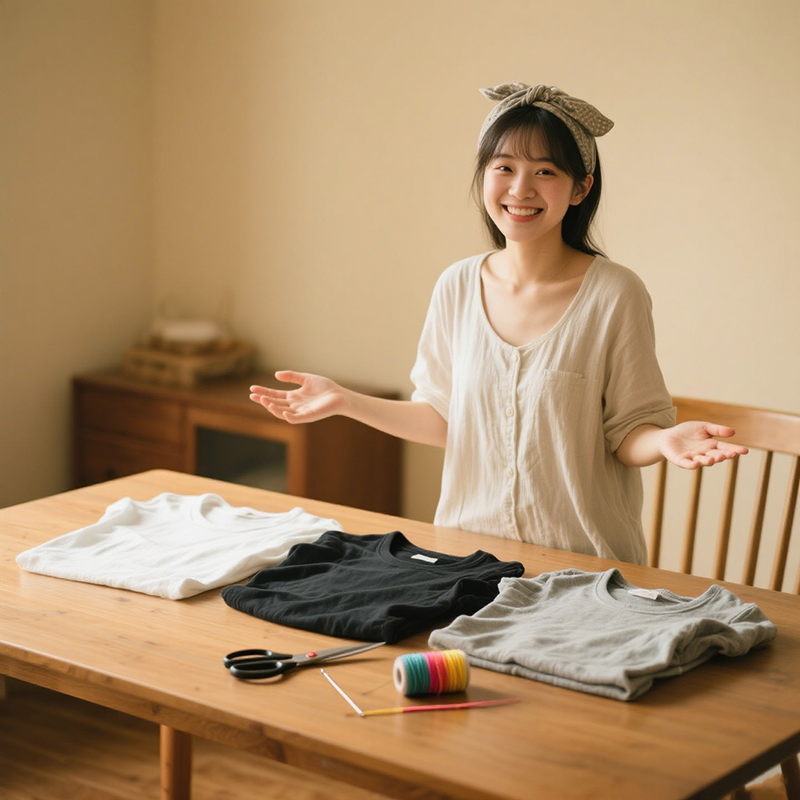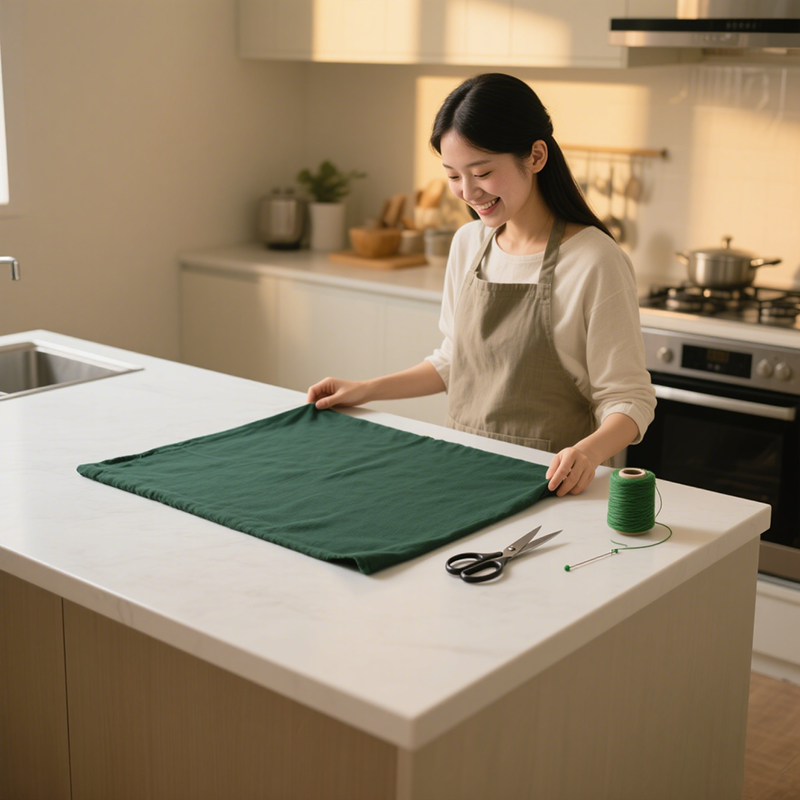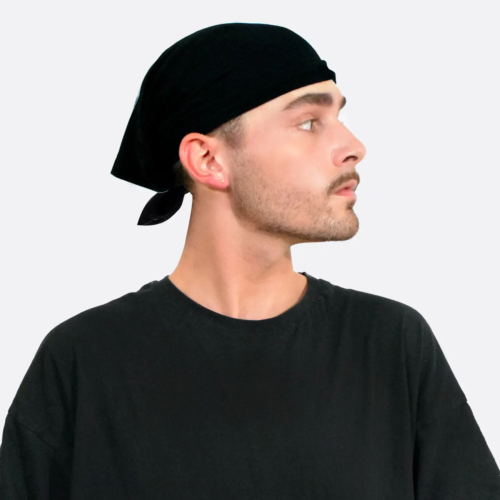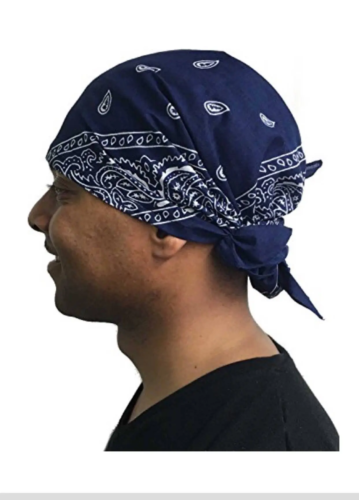الباندانا المربعة عملية وجميلة، ويمكن استخدامها في كل شيء، من ربط الشعر إلى التزيين وحتى الطوارئ. إذا كنتِ ترغبين في الحصول على وشاح مميز، باندانا مربعةلا تحتاجين إلى مهارات معقدة، فقط مواد بسيطة وبضع خطوات لصنع إكسسواراتك الخاصة. تعالي وشاهدي كيف تصنعينها.
جدول المحتويات
تبديل1. باندانا من القماش الأساسي (مناسبة للارتداء اليومي)
إعداد المواد
1. قماش مربع (حرير، ساتان، بوليستر، قطن، كتان، إلخ، الحجم الموصى به 20-28 بوصة، حوالي 50-70 سم، يمكن تعديله وفقًا لمحيط الرأس)، يمكن اختيار نمط القماش وفقًا لتفضيلاتك.
2. مقص، إبرة وخيط/ماكينة خياطة، مسطرة، مكواة

الخطوات التفصيلية
1. قص القماش المربع
افردي القماش بشكل مسطح، ثم قومي برسم مربع بمسطرة (مثل 22×22 بوصة)، ثم قومي بالقطع على طول الخط المحدد للتأكد من أن الحواف الأربعة أنيقة.
نصائح: إذا كان من السهل فك خيوط القماش، يمكنك أولاً استخدام المكواة لتجعيد الحواف.
2. معالجة الحواف (لمنع فك الخيوط)
الطريقة الأولى: الحاشية
اطوِ الحافة للداخل بمقدار ٠.٥ سم، ثم افردها بمكواة، ثم اطوِها بمقدار ١ سم لتكوين حاشية مزدوجة. استخدم إبرة وخيطًا أو ماكينة خياطة للخياطة على طول الحافة بمسافة ٠.٣ سم (طول غرزة متساوٍ). يمكن طي الزوايا الأربع قطريًا وخياطتها لتجنب انتفاخها.
الطريقة الثانية: الإغلاق
إذا كانت هناك آلة خياطة، قومي بعمل خياطة على طول الحافة مباشرة؛ إذا لم يكن الأمر كذلك، يمكنك استخدام طريقة الغرزة المتعرجة (الشكل المتعرج) لخياطة الحافة يدويًا لتقليل فك الخيط.
3. الانتهاء من الباندانا
بعد الخياطة قومي بقص أطراف الخيط وقومي بكوي غطاء الرأس بالمكواة حتى يصبح مسطحًا ويمكن استخدامه.
2. إعادة بناء القمصان القديمة وتحويلها إلى باندانا (اصنعها بنفسك بدون تكلفة)
1.إعداد المواد
قمصان قديمة (يوصى باختيار ألوان سادة أو أنماط بسيطة)، مقص، إبرة وخيط (اختياري)

خطوات
1. قص حافة القميص
ابحث عن حافة القميص (عادة ما تكون ذات حواف مرنة)، وقم بقياس 15-20 سم من الحافة إلى الأعلى (اضبط وفقًا لعرض الحجاب)، ثم قم بالقص على طول المحيط للحصول على شريط دائري من القماش.
مثال: إذا كنت تريدين عمل حجاب عريض، قومي بقص 20 سم؛ وإذا كنت تريدين عمل حجاب ضيق، قومي بقص 10-15 سم.
2. التمدد والتشكيل
قم بمد شريط القماش الدائري بقوة بحيث تتجعد حوافه بشكل طبيعي، مما يشكل نسيجًا ناعمًا للحجاب.
ترقية إبداعية: إذا كنت تريد زيادة الشعور بالتصميم، يمكنك قطع عدة شرائط عمودية على الشريط الدائري من القماش (دون قطعه)، وتمديده لتشكيل تأثير الشرابة.
3. اصنعي وشاحًا مثلثًا (بأسلوب ريترو)
1.إعداد المواد
قماش مستطيل (الحجم الموصى به 30 × 60 بوصة، حوالي 75 × 150 سم)، مقص، إبرة وخيط (اختياري)

خطوات
1.القطع القطري
اطوِ القماش المستطيل إلى نصفين على طول الخط القطري لتشكيل مثلث كبير، ثم قصيه على طول خط الطي بالمقص (إذا كان القماش كبيرًا بما يكفي، يمكنك استخدام القماش المثلث مباشرة).
مثال: إذا كنت تستخدمين قماشًا مربعًا، فيمكنك الحصول على غطاء رأس مثلث عن طريق طيه إلى نصفين وقطعه.
2. معالجة الحافة (اختياري)
إذا كان القماش سهل الفك، يمكنك الرجوع إلى طريقة الخياطة المجعدة للحجاب الأساسي وإجراء معالجة القفل أو التجعيد على الجوانب الثلاثة للوشاح المثلث؛ إذا كنت تسعى إلى نمط غير رسمي، يمكنك الاحتفاظ بالحواف الخام مباشرة.
4. تزيين الباندانا وطرق إبداعية للعب
تطريز الزينة
استخدمي خيوطًا ملونة لتطريز الحروف والأنماط (مثل الزهور الصغيرة والنجوم) على زاوية الحجاب لإضافة عناصر شخصية.
عملية الصباغة التعادلية
استخدمي غطاء رأس قطني أبيض اللون لصبغة التعادل: اطوي القماش أو اجمعيه، ثم اغمسيه في الصبغة (يمكنك شراء مجموعات صبغ التعادل عبر الإنترنت)، ثم جففيه لتشكيل نمط تدرج فريد من نوعه.
ترقيع
استخدمي قصاصات من ألوان مختلفة لصنع أنماط هندسية وخياطتها على غطاء الرأس لإنشاء نمط بوهيمي.
بعض النصائح
1. مناسب للمبتدئين: إذا كنت لا ترغب في الخياطة، يمكنك اختيار القماش الذي لا يتفكك مباشرة (مثل الفلانيل) واستخدامه مباشرة بعد القطع؛ أو استخدام الغراء الساخن بدلاً من الإبرة والخيط للصق الحواف.
2. مقاس مرن: يمكن تصغير مقاس حجاب الأطفال إلى 15×15 بوصة (حوالي 38 سم)، ويمكن للبالغين تعديله حسب محيط الرأس. يُنصح بترك مسافة كافية.
3. اختيار المواد: القطن والكتان قابلان للتنفس وامتصاص العرق في الصيف؛ الصوف والأقمشة المحبوكة متوفرة في الخريف والشتاء للدفء.




